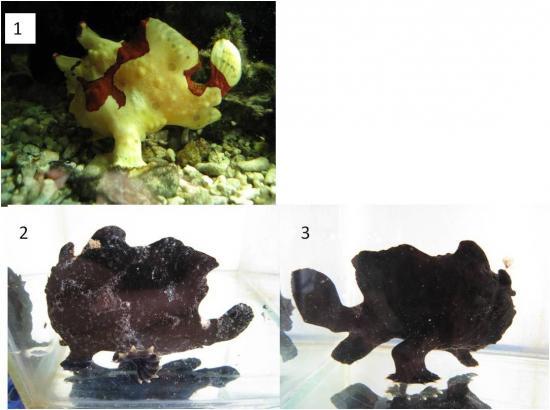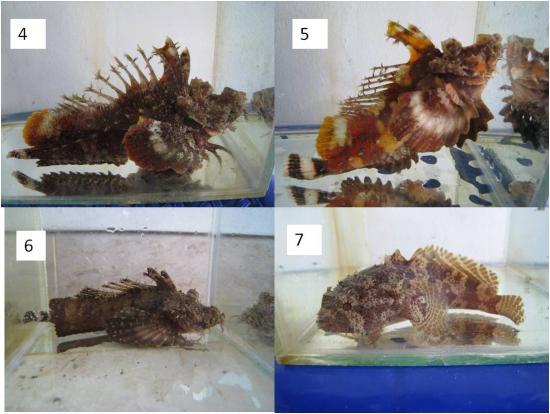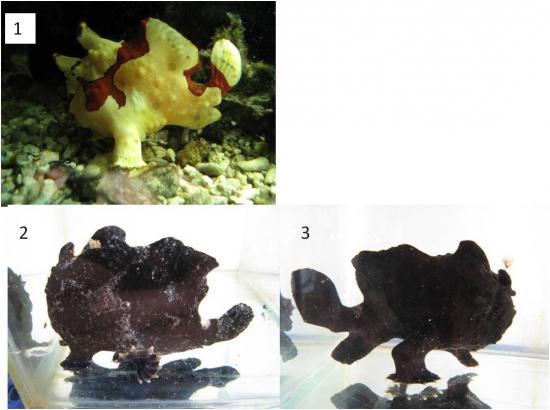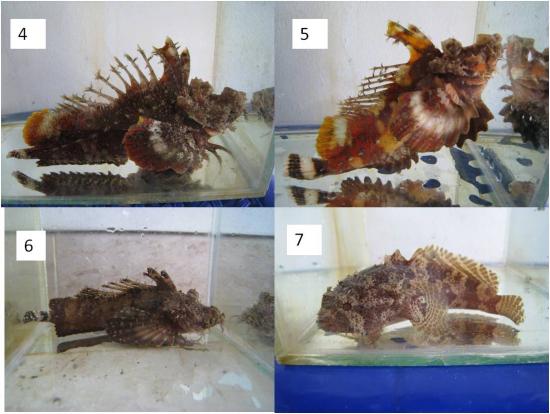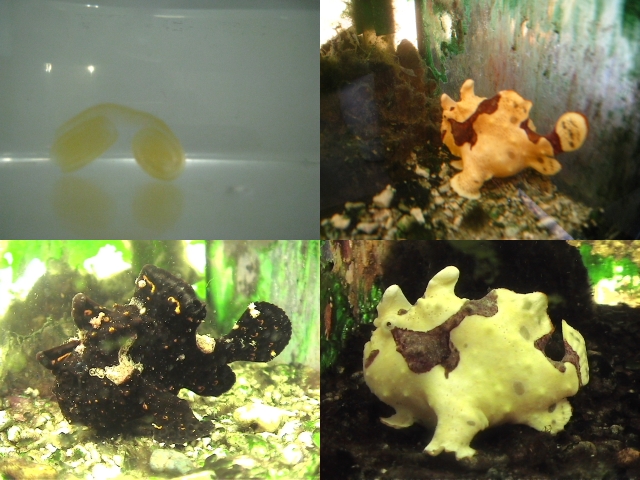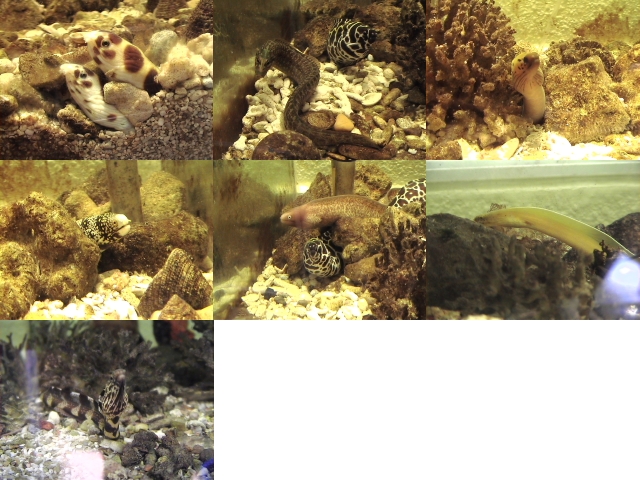
Synanceia
SRC Member-
Posts
208 -
Joined
-
Last visited
Content Type
Profiles
Forums
Gallery
Everything posted by Synanceia
-
Re-post: selling frogfish and devilfish
Synanceia replied to Synanceia's topic in Sell off/Pasar Malam Shop
Price reduced: Fish 1 - $60 Fish 2 - $30 Fish 3 - $30 Fish 4 - $15 Fish 5 - $15 Fish 6 - $15 Fish 7 - $10 All are stable and eating well. -
Fish 1 - white with red warty frogfish. original price $120, selling for $80. About 2.5 to 3 inches. Been with me for 3 years. Fish 2 - black frogfish. original price $60, selling for $40. About 2.5 to 3 inches. Been with me for 2 years. Fish 3 - black with white dots frogfish. original price $60, selling for $40. About 2.5 to 3 inches. Been with me for 2 years. Note: Fish 2 and 3 are a pair and have just spawned last month, but not sure which is male and which is female. Fish 1 should not be kept together with Fish 2 and 3. Fish 4 - Inimicus. original price $40, selling for $20. About 4.5 to 5 inches. Been with me for 3 years. Fish 5 - Inimicus. original price $40, selling for $20. About 4 inches. Been with me for 1.5 years. Fish 6 - Inimicus. original price $40, selling for $20. About 4 inches. Been with me for 2.5 years. Fish 7 - Toadfish. original price $30, selling for $15. About 3 inches. Been with me for 2 years. Viewing and collection only on weekends daytime near Tanah Merah MRT station. Discount given if buy 3 or more fish. Please pm me if interested. Thank you.
-
Selling Livestock - Frogfish and Devilfish
Synanceia replied to Synanceia's topic in Sell off/Pasar Malam Shop
They are fed ghost shrimps, which they will then catch and suck into their mouths. All the fish are ambush predators. The shrimps are fed with marine pellets/flakes 20 minutes before they are thrown in so that the fish get the nutrients they need. -
Fish 1 - white with red warty frogfish. original price $120, selling for $80. About 2.5 to 3 inches. Been with me for 3 years. Fish 2 - black frogfish. original price $60, selling for $40. About 2.5 to 3 inches. Been with me for 2 years. Fish 3 - black with white dots frogfish. original price $60, selling for $40. About 2.5 to 3 inches. Been with me for 2 years. Note: Fish 2 and 3 are a pair and have just spawned last month, but not sure which is male and which is female. Fish 1 should not be kept together with Fish 2 and 3. Fish 4 - Inimicus. original price $40, selling for $20. About 4.5 to 5 inches. Been with me for 3 years. Fish 5 - Inimicus. original price $40, selling for $20. About 4 inches. Been with me for 1.5 years. Fish 6 - Inimicus. original price $40, selling for $20. About 4 inches. Been with me for 2.5 years. Fish 7 - Toadfish. original price $30, selling for $15. About 3 inches. Been with me for 2 years. Viewing and collection only on weekends daytime. Please pm me if interested. Thank you.
-
If you have more than 1 froggy in your tank, you should drop one shrimp each time into the tank to make sure that they have equal feeding opportunities. I use chopsticks* to guide the shrimp# to each froggy, and actually count how many they eat. If your froggies are hungry@ enough, they will learn to congregate at the front of the tank when you approach. *Get three pairs of unused disposable chopsticks (un-separated). Tie them together using rubber bands so that they form a long stable 'food-stick'. #Gut load the FW shrimps (also called ghost shrimps) before you feed. I normally feed my shrimps once in 2 days with normal fish food. You can feed the shrimps anything, from spirulina to shreds of fish purchased from wet markets. Before you drop the shrimp in, use your nails to nip the area before the tail so that it is slightly broken - this will make the shrimp less 'jumpy' and unable to swim fast. This will also enable you to use the 'food-stick' above to usher it to where the frogfish is. The 'food-stick' is also useful to push other more aggressive frogfishes away when they approach, so that the shrimp is eaten by the frogfish you intend to feed. If you have to 'force' your frogfish to eat - i.e. using the foodstick to make the shrimp move back and forth in front of the froggy - that means it is not interested to feed anymore and you should stop. Most times, your froggies will just eat and eat, and it is you who should stop dropping the shrimps in. @I feed my froggies either once or twice a week. In this way, you can tell if they are keen to feed (this means that they are healthy) or not (a frogfish refusing to eat after 4 to 7 days of hunger is likely to go up lorry). Notes on colour change: some black ones may become less black and turn into grey/blackish brown. The red and orange froggies change colours - they may become less bright, and commonly change into yellow/brownish yellow. The warty froggies are more resistant to colour change, but can still happen, especially the black warties. Notes on bullying: some froggies can be aggressive and will display and flare up their fins and puff up their bodies to other froggies (no matter whatever species of froggies). It is better to isolate it because it will bully the other party to death. If your froggies are happy, you may get pairing up and egg rafts. I do not like my froggies to lay eggs, because they can become very eager to lay more eggs, and die in the process (I speculate that they are expending too muh energy in mating and not eating enough to replenish. If you get an egg raft every 5 days, then it is better to separate the female from the male and let her recuperate before she goes up lorry). My two cents and HO. I currently have 6 froggies in 3 tanks.
-
Hi Bro Fuel, Care to post a pic of your Parapterois for all to share? Thanks.
-
LFS in Kuala Lumpur
Synanceia replied to Synanceia's topic in Weekly LFS Stocks Report / LFS Info Centre
Thanks -
Just like to find out if anybody knows of any good LFS in Kuala Lumpur selling marine fish, preferably near the city centre. Thanks.
-
As promised, pictures of the egg raft if I see it again. Top left picture is the egg raft taken on the first day (today, 28 Mar 09) - incidentally they were laid in the afternoon, as the female was still swollen in the morning when I left home. Top right picture is the female warty swollen with eggs (not swollen enough yet as this was taken yesterday 27 Mar 09. She was really very swollen this morning) - now I know that it is a she. Bottom left and right pictures are the parents of the egg raft. To be honest, I'm not excited by the egg laying, as the two specimens are still juvenile in size (IMHO) and they are producing 2 clutches 2 weeks apart. I hope I don't get anymore eggs, else I may have to separate the pair, but I don't have any spare tanks! The egg raft also seems to have some foci of eggs which are fungal infected (bigger white dots amongst the small black ones). On the other hand, they could be unfertilised. I'll just wait and see if they hatch out. One other major headache is that my external air pump just crashed (refused to work). I'll have to get one very soon. I'm now relying on 2 backup air pumps. Fingers crossed
-
The larvae in the website came from the eggs produced by my previous pair in Mar 2008. You can refer to my posting on 6 Mar 2008 - 'Hatching of Antennarius sp. eggs' for the pictures of the parents.
-
I can share my observations with you. The difficult part is what to do after obtaining the eggs, since the fry are minute and will require microplankton as food. You can also refer to my previous postings for pictures. It is not possible to sex the fish, so pairings happen by chance. If you have a compatible pair in a tank, you may see signs of courtship, which include flaring of fins and tail, stiffening and spasming of the body, vigorous sideways movement of the tail end of the body. Incidentally, the threat posture of one frogfish towards another also looks the same as the courtrhip dance, so you won't be sure until you see an egg raft floating on the upper water layer. The egg raft is an elongated gelatinous mass with many black dots (the eggs). It floats around for about 3 to 4 days, after which it 'disintegrates', which also signifies hatching of the eggs. The female before egg laying will swell her abdominal area considerably to accommodate the increased volume of the eggs. One thing I have also noticed is that if the pair produces an egg raft continuously week after week, they will die eventually from refusing to eat and possibly exhaustion. I have had 4 confirmed pairs durimg the past years, the most current pair being a black warty and a white warty with dark brown streaks. They produced an egg raft just before I went overseas last week, so I didn't bother taking photos. Maybe next time. Hope this helps.
-
Will like to share this with fellow anglerfish lovers: the successful hatching of a clutch of eggs. This is the second clutch produced by a compatible pair (have no idea which is the male or female cos the mating and laying processes were not observed). The first clutch was laid three weeks ago, but was ignored cos I was preparing for house-moving. This second clutch, interestingly, was produced after a supposedly stressful period of temporary holding: 23 Feb - fish moved to temporary holding tanks (possibly about one-tenth the volume of their normal holding tank); 24 Feb - tanks shifted to new apt and partially changed water in holding tank; 25 Feb - tanks set up and fish placed in them after an interval of 6 hrs (the water in the holding tanks was fouling and there was no choice but to place the fish into the newly set up tanks with the old rocks and gravel. My feeling was that one more night in the holding tanks would have resulted in casualties); 26 Feb - egg mass seen at night; 27 to 28 Feb - egg mass did not disintegrate; 28 Feb night - egg mass placed in a small plastic tank with strong aeration; 29 Feb - egg mass disintegrating but the transparent eggs can be seen dispersed throughout the water with a little black dot at the side ( probably embryoes); 29 Feb night - eggs hatched and the tiny 1mm fry can be seen under strong light with wriggling tails and yolk sac; 1 Mar - fry given to fellow enthusiast with experience in raising reef fish fry. The fry float on the surface when aeration is withdrawn, hence in the wild, they probably form part of the zooplankton at the top water layer. This is not the first time that I have a compatible pair of anglers. My very first pair had produced a clutch of eggs every week for a month and I think the intense egg laying killed both. After the last clutch of eggs both refused to eat and died. Hopefully this current pair will not produce eggs so frequently (currently a three week interval between the first and second clutch) and will survive. Will post if there are fresh developments.
-
Unfortunately I can't identify them all. I have just bought three more eels - I think they are of the same species. Pictures will be shown in future. The yellow colour of the tank water is light reflected off the cream coloured wall adjacent to the tank, plus the dark colour of the tank sides which are covered by brown algae. I have since removed the algae and the tank is brighter now. The tank must be covered properly. I have lost two fimbriated morays in two consecutive months when they jumped out of the tank and were not discovered. I nearly lost a Myrichthys maculosus when it too lept out of the tank, but luckily I found it before it dried up. Took the fellow about two weeks to recover from the ordeal and start feeding again. The eels can become accustomed to taking food from your fingers. Be careful though, that they don't sink their teeth into your fingers in the process. It will be more of a surprise than pain when they do that. The eels can also become hunters of small fish. It is better not to keep bite-sized fish with them. And yes, they can take bites off one another. So far, the ones bitten have managed to recover. Just early this year, the white ribbon eel had one gaping wound about 0.5cm in diameter in the cranial part of its abdominal wall. It didn't eat for about an entire month and I thought that it was going to die. But it survived and it is now hungrier than before. Shifting to larger tanks is definitely a must when the eels grow bigger.
-
The big ones are kept in a 3 ft tank, the small ones in a 2.5 ft tank. Bought them from various LFS.
-
The big ones (the first 7 pics) are all in the same tank. Curiously, the white ribbon eel has been with me for 2 years, and despite its regular intake of food, it grows very slowly. I have 2 'enigmatic eels' (sorry, don't know if this is their correct name) which are still quite small, and are kept with the ribbon eel and another moray in a separate tank. They are all fed thawed cut fish, except for the white ribbon eel, which eats only ghost shrimp.
-
Bought from various LFS. They grow quite fast. They were all small in size when I bought them - around 1/2 inch in width and not more than 6 inches long. Now the biggest is 1.5 inches across and ard 10 inches or more long.
-
-
Pics of my gurnards feasting on frozen mysis. I now have 10 of them in a 3-ft tank. Feeding is once a day. The Parapterois heterura is also shown.
-
The two which spawned are about 3 to 4 inches long. Can't differentiate male and female just by external appearance. However, during courtship and spawning, the one with the bulging stomach (filled with eggs) is the female.
-
Hi Bro Jameshong, My experience with hyperventilating frogfish is that they usually die, unless under these situations: (1) they have just been introduced to the tank and had been dashing around the tank for a while, or been highly agitated. The breathing should settle or return to normal within a few hours. (2) they have just eaten a heavy meal (stomach is usually bulging) - can take up to half - 1 day to settle. (3) they have just 'squared off' with another frogfish after threatening displays - takes pretty fast to return to normal. Otherwise, the prognosis is not good. My two cents worth.
-
If you see the same species again, please let me know. The gurnards and this fellow are kept in a 3-ft tank. They range from 1.5 to 3 inches, so still comfortable. I have two 4-ft tanks awaiting if space runs out.
-
I ws going to place the eggs in a habitat where the fry would have a reasonable chance of survival. The area can support reef organisms. Even if the fry hatch out in my tank, there is no chance of me raising them.
-
Think you are right, Terryz. Coincidentally, I am keeping it in the same tank as my small colony of flying gurnards and an oriental gurnard.
-
Six between 2.5 to 3 inches, one between 1.5 to 2 inches, two between 1 to 1.5 inch. I avoid getting bigger than 3 inches or below 1 inch cos the big one will eat the small one - that will be a very expensive meal.

